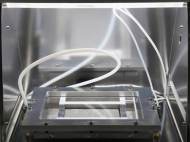Air Clean pavement slabs clean air from nitrogen oxide
 We already wrote about several projects where pavement could be used to generate energy, and in this article we’re going to write about progress in technology used to clean the air with usage of a special pavement. Coated in titanium dioxide nanoparticles, pavement is able to reduce the amount of nitrogen oxide in the air. That ability seems useful to Germans who measured the concentrations of toxic nitrogen oxide with results it exceeds the maximum permitted levels.
We already wrote about several projects where pavement could be used to generate energy, and in this article we’re going to write about progress in technology used to clean the air with usage of a special pavement. Coated in titanium dioxide nanoparticles, pavement is able to reduce the amount of nitrogen oxide in the air. That ability seems useful to Germans who measured the concentrations of toxic nitrogen oxide with results it exceeds the maximum permitted levels.
In 2009, the amounts of toxic nitrogen oxide in the atmosphere exceeded the maximum permitted levels at no fewer than 55 percent of air monitoring stations in urban areas of Germany. The ministry reports that road traffic is one of the primary sources of these emissions. Special paving slabs that will clean the air are to be laid through the length of Petersberger Straße in the Baroque city of Fulda, where recorded pollution levels topped the annual mean limit of 40 micrograms per cubic meter (μg/m3) last year.
Titanium dioxide is a photocatalyst – it uses sunlight to accelerate a naturally occurring chemical reaction, the speed of which changes with exposure to light. The Air Clean nitrogen oxide-reducing paving slabs were developed by F. C. Nüdling Betonelemente. Proof of their effectiveness has subsequently been provided by the Fraunhofer Institute for Molecular Biology and Applied Ecology IME in Schmallenberg, where researchers also determined the risk to the environment posed by the resulting nitrates.
Dr. Monika Herrchen, a scientist at the Fraunhofer IME, said: “Experiments in Italian cities had already shown that photocatalytic paving slabs can improve the air quality. We wanted to see if they would also be effective here in Germany, where we have lower levels of light intensity and fewer hours of sunshine. Of course, the more intense the sunshine, the quicker the degradation of harmful substances, so our aim was to identify the formula with the highest photocatalytic efficiency rating.”
Since the nitrogen oxide degradation rates achieved using standard commercial photocatalytic cement (i.e. cement that reacts to solar radiation) proved unsatisfactory, the company ultimately had to develop its own, more effective formula. Concrete manufacturer F.C. Nüdling produced a range of sample slabs incorporating different surfaces, colors, types of cement and TiO2 contents.
During an extended time field test, the researchers recorded nitrogen oxide degradation rates of 20 to 30 percent in specially-created street canyons. The measurements were taken at a height of three meters above the photocatalytic slabs, in variable wind and light conditions. When the wind was still, the experts recorded degradation rates as high as 70 percent for both nitrogen monoxide (NO) and nitrogen dioxide (NO2). Measurements likewise taken at a height of three meters above the Gothaer Platz in Erfurt, which is already paved with Air Clean paving slabs, revealed an average degradation rate of 20 percent for NO2 and 38 percent for NO.
The nitrate that is generated during the conversion process poses absolutely no risk to the environment. It runs off into the drainage system, then into a wastewater treatment plant, before finally ending up on a farmer’s field or in the groundwater. The maximum possible nitrate concentration traceable back to photocatalytic reactions is around five milligrams per liter (mg/l), while the maximum permitted concentration of nitrate in groundwater is 50 mg/l.
Although the pavement remains stable over the long term and their recorded measurements confirm they are still effective after 14 to 23 months, there is a need to make further development of a similar technology that is able to purify the air even more effectively and at a lower price (the material cost is 50% larger compared to ordinary concrete). The potential biggest downside of such a project is in the usage of TiO2 itself, since many researchers claim it may be a carcinogen.









Leave your response!